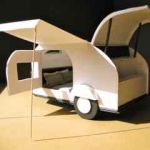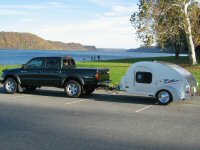battery question/solar recharge also
19 posts
• Page 1 of 2 • 1, 2
battery question/solar recharge also
I'm thinking through a couple of design ideas and thought I would pose a couple of questions here regarding batteries. I am also going to say that my dad tried to explain to me watts and amps and one of them can kill you and the other just makes you wet your pants, but I honestly cannot remember which is which.
If I plan on camping away from power sources, how do I figure out how 'long' I could run my teardrop (only using LED puck lights in the cabin for one hour average and the fantastic fan on high for 8 hours a night) using a deep cycle marine battery? I am imagining that we would usually be in one place no longer than two days. That would mean that the battery would trickle charge while driving and then the whole system would engage again.
I'm looking into an 85 Watt Solar panel to charge the battery during the day while we are out exploring, etc.
Does anyone out there use their solar panel to charge a second battery while driving? I know a lot of people use a trickle charge from the tow vehicle while they are driving. Is there any logic for using the solar panel to charge the main battery rather than the trickle charge? Could you have a second battery to 'store' the solar energy that is generated? I'm thinking about while you are driving down the road, the top of the trailer would almost always be exposed to the sun, this would be a great time to harvest the solar power, no?
Thanks in advance for you patience.
Todd
If I plan on camping away from power sources, how do I figure out how 'long' I could run my teardrop (only using LED puck lights in the cabin for one hour average and the fantastic fan on high for 8 hours a night) using a deep cycle marine battery? I am imagining that we would usually be in one place no longer than two days. That would mean that the battery would trickle charge while driving and then the whole system would engage again.
I'm looking into an 85 Watt Solar panel to charge the battery during the day while we are out exploring, etc.
Does anyone out there use their solar panel to charge a second battery while driving? I know a lot of people use a trickle charge from the tow vehicle while they are driving. Is there any logic for using the solar panel to charge the main battery rather than the trickle charge? Could you have a second battery to 'store' the solar energy that is generated? I'm thinking about while you are driving down the road, the top of the trailer would almost always be exposed to the sun, this would be a great time to harvest the solar power, no?
Thanks in advance for you patience.
Todd
-

burlesot - Teardrop Master
- Posts: 280
- Images: 62
- Joined: Mon Jul 16, 2012 3:10 pm
Re: battery question/solar recharge also
In short, I think your plan is fine and viable. OK Tex? (an inside joke).
burlesot wrote:I'm thinking through a couple of design ideas and thought I would pose a couple of questions here regarding batteries. I am also going to say that my dad tried to explain to me watts watts is the product of amps and voltage (A times V) and amps is the amount of current or electrons flowing and one of them can kill amps are more important than voltage and if you have enough amps to kill you you, by the formula A times V, you have enough watts to kill you you and the other just makes you wet your pants, but I honestly cannot remember which is which.
I you wanna simple explanation voltage is like water pressure. Amperage is like water flow. Watts is the energy in the flow. Flow times pressure.
If I plan on camping away from power sources, how do I figure out how 'long' I could run my teardrop (only using LED puck lights in the cabin for one hour average and the fantastic fan on high for 8 hours a night) using a deep cycle marine battery? I am imagining that we would usually be in one place no longer than two days. That would mean that the battery would trickle charge while driving and then the whole system would engage again.
Your LED lights will draw minimum current. Your fantastic fan will draw a maximum of three amps or 24 amp hours during 8 hours (amps time hours). Figure 30 amp hours a day max for your lights and fan 9(this is probably several amp hours high). An 85 watt panel should produce (on an average) 4 or 5 amps perhaps 6 or 7 hours a day. Maybe more or less depending on the time of year, the weather, and where it's placed. This figure may be low. So your going to get pretty close each day put back into the battery to the same amount your drawing out of your battery. If you have a hundred amp/hour battery you can draw about 50 amp hours out if it and not damage it. So, IMHO, you'll do fine with an 85 watt solar panel and a battery rated for 100 amp/hours.
Charging your battery while driving is a good thing and it will be far more than a "trickle charge". I'd figure on 3 or 4 amp hours for each hour of driving and this is probably very conservative.
I'm looking into an 85 Watt Solar panel to charge the battery during the day while we are out exploring, etc.
Does anyone out there use their solar panel to charge a second battery while driving? I know a lot of people use a trickle charge from the tow vehicle while they are driving. Is there any logic for using the solar panel to charge the main battery rather than the trickle charge? Could you have a second battery to 'store' the solar energy that is generated? I'm thinking about while you are driving down the road, the top of the trailer would almost always be exposed to the sun, this would be a great time to harvest the solar power, no?
Thanks in advance for you patience.
Todd
The opinions in this post are my own. My comments are directed to those that might like an alternative approach to those already espoused.There is the right way,the wrong way,the USMC way, your way, my way, and the highway.
"I'm impatient with stupidity. My people have learned to live without it." Klaatu-"The Day the Earth Stood Still"
"You can't handle the truth!"-Jack Nicholson "A Few Good Men"
"Some people spend an entire lifetime wondering if they made a difference in the world. The Marines don't have that problem"-Ronald Reagan
"I'm impatient with stupidity. My people have learned to live without it." Klaatu-"The Day the Earth Stood Still"
"You can't handle the truth!"-Jack Nicholson "A Few Good Men"
"Some people spend an entire lifetime wondering if they made a difference in the world. The Marines don't have that problem"-Ronald Reagan
-

eamarquardt - Silver Donating Member
- Posts: 3179
- Images: 150
- Joined: Sat Nov 11, 2006 11:00 pm
- Location: Simi Valley, State of Euphoria (Ca)









